
The swallows, martins, and saw-wings, or Hirundinidae are a family of passerine songbirds found around the world on all continents, including occasionally in Antarctica. Highly adapted to aerial feeding, they have a distinctive appearance. The term "swallow" is used as the common name for Hirundo rustica in the UK and Ireland. Around 90 species of Hirundinidae are known, divided into 21 genera, with the greatest diversity found in Africa, which is also thought to be where they evolved as hole-nesters. They also occur on a number of oceanic islands. A number of European and North American species are long-distance migrants; by contrast, the West and South African swallows are nonmigratory.

The red-rumped swallow is a small passerine bird in the swallow family. It breeds in open hilly country of temperate southern Europe and Asia from Portugal and Spain to Japan, India, Sri Lanka and tropical Africa. The Indian and African birds are resident, but European and other Asian birds are migratory. They winter in Africa or India and are vagrants to Christmas Island and northern Australia.

The red-breasted swallow, also known as the rufous-chested swallow, is a member of the family Hirundinidae, found in Sub-Saharan Africa. It is confined to the tropical rainforest during the wet season.
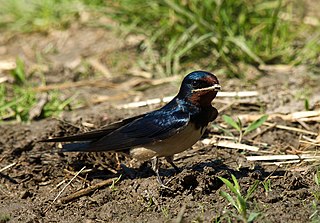
The bird genus Hirundo is a group of passerines in the family Hirundinidae. The genus name is Latin for a swallow. These are the typical swallows, including the widespread barn swallow. Many of this group have blue backs, red on the face and sometimes the rump or nape, and whitish or rufous underparts. With fifteen species this genus is the largest in its family.
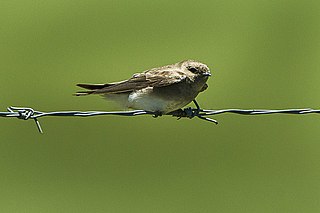
The brown-throated martin or brown-throated sand martin is a small passerine bird in the swallow family, Hirundinidae, that is widely distributed across Africa. It was formerly regarded as conspecific with the grey-throated martin and the Madagascar martin.
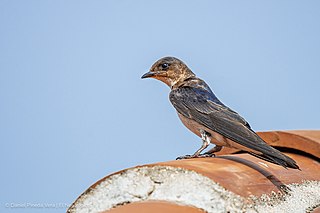
The grey-breasted martin is a large swallow from Central and South America.
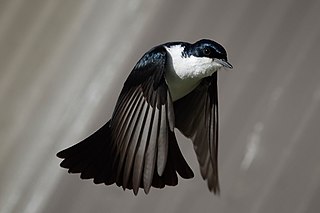
The restless flycatcher or restless myiagra is a passerine bird in the family Monarchidae; it is also known as the razor grinder or scissors grinder because of its distinctive call. It is a native of eastern and southern Australia. Populations in New Guinea and northern Australia, which were at one time considered to be a subspecies, are now accepted as a separate species, the paperbark flycatcher. It is a small to medium-sized bird and has similar colouring to the willie wagtail.

The dusky crag martin is a small passerine bird in the swallow family. It is about 13 cm (5 in) long with a broad body and wings, and a short square tail that has small white patches near the tips of most of its feathers. This martin has sooty-brown upperparts and slightly paler underparts. The two subspecies are resident breeding birds in South Asia from the Indian subcontinent to southwestern China and the northern parts of Thailand, Vietnam and Laos.
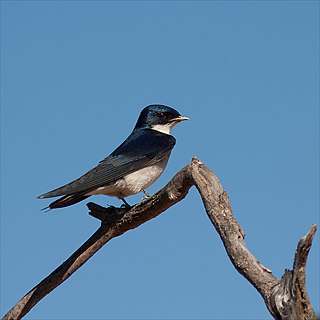
The pearl-breasted swallow is a small swallow.
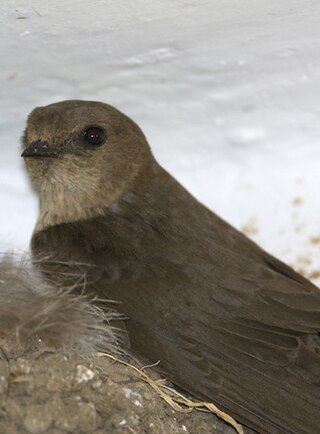
The crag martins are four species of small passerine birds in the genus Ptyonoprogne of the swallow family. They are the Eurasian crag martin (P. rupestris), the pale crag martin (P. obsoleta), the rock martin (P. fuligula) and the dusky crag martin (P. concolor). They are closely related to each other, and have formerly sometimes been considered to be one species. They are closely related to the Hirundo barn swallows and are placed in that genus by some authorities. These are small swallows with brown upperparts, paler underparts without a breast band, and a square tail with white patches. They can be distinguished from each other on size, the colour shade of the upperparts and underparts, and minor plumage details like throat colour. They resemble the sand martin, but are darker below, and lack a breast band.

The tawny-headed swallow is a species of bird in the family Hirundinidae. It is the only species placed in the genus Alopochelidon. It is found in Argentina, Bolivia, Brazil, Colombia, Falkland Islands, Paraguay, Peru, Uruguay, and Venezuela, where its natural habitats are dry savanna and subtropical or tropical seasonally wet or flooded lowland grassland.

The white-banded swallow is a species of bird in the family Hirundinidae. It is black with white thighs, a white breast, and has white bars on the edges of its wings. It has a distinct, deeply forked tail.

The black-backed butcherbird is a species of bird in the family Artamidae. It is found in southern New Guinea and Cape York Peninsula in Queensland, Australia.

The southern scrub robin is a species of bird in the family Petroicidae. It is endemic to Australia, where it occurs in mallee and heathland in the semi-arid southern parts of the continent, extending from Wyperfeld National Park in Victoria in the east through South Australia to the west coast between Kalbarri and the Pinnacles in Nambung National Park.

The pied-winged swallow is a species of bird in the family Hirundinidae. It has distinctive steel-blue upperparts with white wing patches. It is native to parts of West Africa.

The white-tailed swallow is a small swallow belonging to the family Hirundinidae and is endemic to Oromia, Ethiopia. It is commonly referred to as "Benson's swallow" after the ornithologist Constatine Walter Benson, who named the species. This small bird is classified as a vulnerable species by the International Union for Conservation of Nature (IUCN), as there is a progressive declination of the species which now consists of less than 10,000 adult individuals worldwide. It has a surprisingly small range for a swallow, as it is wholly dependent on a cooler "bubble" surrounding its small range, likely for proper breeding success. It is one of the most threatened bird species by climate change and a massive range reduction is projected in the future.
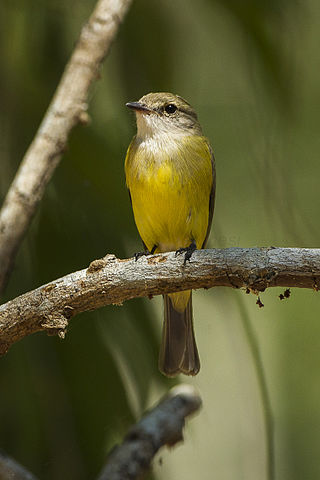
The lemon-bellied flyrobin or lemon-bellied flycatcher is a species of bird in the family Petroicidae. Found in Australia, Indonesia, and Papua New Guinea, its natural habitats are subtropical or tropical moist lowland forests and subtropical or tropical mangrove forests.
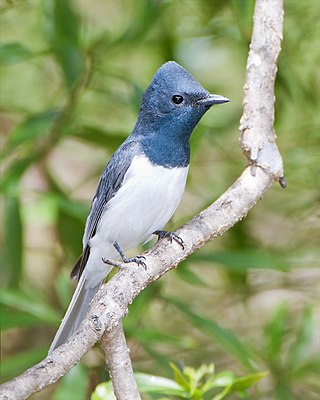
The leaden flycatcher is a species of passerine bird in the family Monarchidae. Around 15 cm (6 in) in length, the male is lustrous azure with white underparts, while the female possesses leaden head, mantle and back and rufous throat and breast. It is found in eastern and northern Australia, Indonesia, and Papua New Guinea. Its natural habitat is subtropical or tropical mangrove forests in the northern parts of its range, in the south and inland it is eucalypt woodland.

Brazza's martin is a passerine bird in the swallow family, Hirundinidae. It is 12 centimeters (4.7 in) long with grey-brown upperparts, heavily black-streaked white underparts, and a brownish tint to the breast plumage. The sexes are similar, but juvenile birds have more diffuse breast streaking and reddish-brown edges to the feathers of the back and wings. The song consists of a series of short notes of increasing frequency, followed by a complex buzz that is sometimes completed by a number of clicks.

The mallee emu-wren is a species of bird in the Australasian wren family, Maluridae. It is endemic to Australia.
























